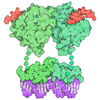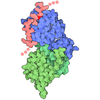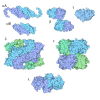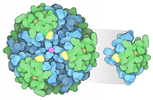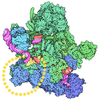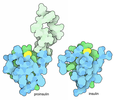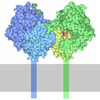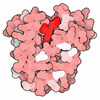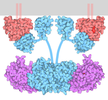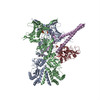[English] 日本語
 Yorodumi
Yorodumi- PDB-7krj: The GR-Maturation Complex: Glucocorticoid Receptor in complex wit... -
+ Open data
Open data
- Basic information
Basic information
| Entry | Database: PDB / ID: 7krj | ||||||
|---|---|---|---|---|---|---|---|
| Title | The GR-Maturation Complex: Glucocorticoid Receptor in complex with Hsp90 and co-chaperone p23 | ||||||
 Components Components |
| ||||||
 Keywords Keywords | CHAPERONE / ligand binding / ATP binding / protein folding / cryo-EM | ||||||
| Function / homology |  Function and homology information Function and homology informationlung saccule development / prostaglandin-E synthase / prostaglandin-E synthase activity / Regulation of NPAS4 gene transcription / nuclear receptor-mediated glucocorticoid signaling pathway / regulation of glucocorticoid biosynthetic process / nuclear glucocorticoid receptor activity / Aryl hydrocarbon receptor signalling / steroid hormone binding / PTK6 Expression ...lung saccule development / prostaglandin-E synthase / prostaglandin-E synthase activity / Regulation of NPAS4 gene transcription / nuclear receptor-mediated glucocorticoid signaling pathway / regulation of glucocorticoid biosynthetic process / nuclear glucocorticoid receptor activity / Aryl hydrocarbon receptor signalling / steroid hormone binding / PTK6 Expression / glucocorticoid metabolic process / neuroinflammatory response / Synthesis of Prostaglandins (PG) and Thromboxanes (TX) / cyclooxygenase pathway / mammary gland duct morphogenesis / microglia differentiation / astrocyte differentiation / maternal behavior / glycogen biosynthetic process / telomerase holoenzyme complex / protein folding chaperone complex / prostaglandin biosynthetic process / cellular response to glucocorticoid stimulus / motor behavior / adrenal gland development / regulation of gluconeogenesis / sperm mitochondrial sheath / sulfonylurea receptor binding / dATP binding / cellular response to steroid hormone stimulus / CTP binding / positive regulation of protein polymerization / vRNP Assembly / Scavenging by Class F Receptors / UTP binding / skin development / sperm plasma membrane / chaperone-mediated autophagy / Respiratory syncytial virus genome replication / Rho GDP-dissociation inhibitor binding / telomerase holoenzyme complex assembly / mitochondrial transport / protein insertion into mitochondrial outer membrane / Uptake and function of diphtheria toxin / Drug-mediated inhibition of ERBB2 signaling / Resistance of ERBB2 KD mutants to trastuzumab / Resistance of ERBB2 KD mutants to sapitinib / Resistance of ERBB2 KD mutants to tesevatinib / Resistance of ERBB2 KD mutants to neratinib / Resistance of ERBB2 KD mutants to osimertinib / Resistance of ERBB2 KD mutants to afatinib / Resistance of ERBB2 KD mutants to AEE788 / Resistance of ERBB2 KD mutants to lapatinib / Drug resistance in ERBB2 TMD/JMD mutants / TPR domain binding / non-chaperonin molecular chaperone ATPase / PIWI-interacting RNA (piRNA) biogenesis / Assembly and release of respiratory syncytial virus (RSV) virions / dendritic growth cone / : / Sema3A PAK dependent Axon repulsion / skeletal muscle contraction / protein unfolding / regulation of postsynaptic membrane neurotransmitter receptor levels / positive regulation of cell size / regulation of protein ubiquitination / estrogen response element binding / HSF1-dependent transactivation / response to unfolded protein / HSF1 activation / regulation of protein-containing complex assembly / FOXO-mediated transcription of oxidative stress, metabolic and neuronal genes / telomere maintenance via telomerase / nuclear receptor-mediated steroid hormone signaling pathway / chaperone-mediated protein complex assembly / Attenuation phase / neurofibrillary tangle assembly / RHOBTB2 GTPase cycle / core promoter sequence-specific DNA binding / axonal growth cone / positive regulation of lamellipodium assembly / eNOS activation / cellular response to transforming growth factor beta stimulus / DNA polymerase binding / Tetrahydrobiopterin (BH4) synthesis, recycling, salvage and regulation / positive regulation of defense response to virus by host / Signaling by ERBB2 / steroid binding / response to salt stress / cardiac muscle cell apoptotic process / TBP-class protein binding / positive regulation of telomere maintenance via telomerase / endocytic vesicle lumen / telomere maintenance / Loss of Nlp from mitotic centrosomes / Loss of proteins required for interphase microtubule organization from the centrosome / positive regulation of cardiac muscle contraction / nitric-oxide synthase regulator activity / Recruitment of mitotic centrosome proteins and complexes / cellular response to dexamethasone stimulus Similarity search - Function | ||||||
| Biological species |  Homo sapiens (human) Homo sapiens (human) | ||||||
| Method | ELECTRON MICROSCOPY / single particle reconstruction / cryo EM / Resolution: 2.56 Å | ||||||
 Authors Authors | Noddings, C.M. / Wang, Y.-R. / Agard, D.A. | ||||||
| Funding support |  United States, 1items United States, 1items
| ||||||
 Citation Citation |  Journal: Nature / Year: 2022 Journal: Nature / Year: 2022Title: Structure of Hsp90-p23-GR reveals the Hsp90 client-remodelling mechanism. Authors: Chari M Noddings / Ray Yu-Ruei Wang / Jill L Johnson / David A Agard /  Abstract: Hsp90 is a conserved and essential molecular chaperone responsible for the folding and activation of hundreds of 'client' proteins. The glucocorticoid receptor (GR) is a model client that constantly ...Hsp90 is a conserved and essential molecular chaperone responsible for the folding and activation of hundreds of 'client' proteins. The glucocorticoid receptor (GR) is a model client that constantly depends on Hsp90 for activity. GR ligand binding was previously shown to nr inhibited by Hsp70 and restored by Hsp90, aided by the co-chaperone p23. However, a molecular understanding of the chaperone-mediated remodelling that occurs between the inactive Hsp70-Hsp90 'client-loading complex' and an activated Hsp90-p23 'client-maturation complex' is lacking for any client, including GR. Here we present a cryo-electron microscopy (cryo-EM) structure of the human GR-maturation complex (GR-Hsp90-p23), revealing that the GR ligand-binding domain is restored to a folded, ligand-bound conformation, while being simultaneously threaded through the Hsp90 lumen. In addition, p23 directly stabilizes native GR using a C-terminal helix, resulting in enhanced ligand binding. This structure of a client bound to Hsp90 in a native conformation contrasts sharply with the unfolded kinase-Hsp90 structure. Thus, aided by direct co-chaperone-client interactions, Hsp90 can directly dictate client-specific folding outcomes. Together with the GR-loading complex structure, we present the molecular mechanism of chaperone-mediated GR remodelling, establishing the first, to our knowledge, complete chaperone cycle for any Hsp90 client. | ||||||
| History |
|
- Structure visualization
Structure visualization
| Movie |
 Movie viewer Movie viewer |
|---|---|
| Structure viewer | Molecule:  Molmil Molmil Jmol/JSmol Jmol/JSmol |
- Downloads & links
Downloads & links
- Download
Download
| PDBx/mmCIF format |  7krj.cif.gz 7krj.cif.gz | 630.5 KB | Display |  PDBx/mmCIF format PDBx/mmCIF format |
|---|---|---|---|---|
| PDB format |  pdb7krj.ent.gz pdb7krj.ent.gz | 522.1 KB | Display |  PDB format PDB format |
| PDBx/mmJSON format |  7krj.json.gz 7krj.json.gz | Tree view |  PDBx/mmJSON format PDBx/mmJSON format | |
| Others |  Other downloads Other downloads |
-Validation report
| Summary document |  7krj_validation.pdf.gz 7krj_validation.pdf.gz | 1.4 MB | Display |  wwPDB validaton report wwPDB validaton report |
|---|---|---|---|---|
| Full document |  7krj_full_validation.pdf.gz 7krj_full_validation.pdf.gz | 1.4 MB | Display | |
| Data in XML |  7krj_validation.xml.gz 7krj_validation.xml.gz | 57.7 KB | Display | |
| Data in CIF |  7krj_validation.cif.gz 7krj_validation.cif.gz | 87.3 KB | Display | |
| Arichive directory |  https://data.pdbj.org/pub/pdb/validation_reports/kr/7krj https://data.pdbj.org/pub/pdb/validation_reports/kr/7krj ftp://data.pdbj.org/pub/pdb/validation_reports/kr/7krj ftp://data.pdbj.org/pub/pdb/validation_reports/kr/7krj | HTTPS FTP |
-Related structure data
| Related structure data |  23004MC M: map data used to model this data C: citing same article ( |
|---|---|
| Similar structure data | |
| EM raw data |  EMPIAR-11028 (Title: Cryo-EM Structures of Glucocorticoid Receptor-Hsp90-p23 [the GR Maturation Complex], Hsp90-p23, and MBP-Hsp90-p23 EMPIAR-11028 (Title: Cryo-EM Structures of Glucocorticoid Receptor-Hsp90-p23 [the GR Maturation Complex], Hsp90-p23, and MBP-Hsp90-p23Data size: 494.1 Data #1: MotionCor2 aligned frames of GR-Hsp90-p23 collected on Gatan K3 [micrographs - single frame] Data #2: Processed subsets [picked particles - single frame - processed]) |
- Links
Links
- Assembly
Assembly
| Deposited unit | 
|
|---|---|
| 1 |
|
- Components
Components
-Protein , 3 types, 4 molecules ABCD
| #1: Protein | Mass: 84781.727 Da / Num. of mol.: 2 Source method: isolated from a genetically manipulated source Source: (gene. exp.)  Homo sapiens (human) / Gene: HSP90AA1, HSP90A, HSPC1, HSPCA / Production host: Homo sapiens (human) / Gene: HSP90AA1, HSP90A, HSPC1, HSPCA / Production host:  #2: Protein | | Mass: 18720.395 Da / Num. of mol.: 1 Source method: isolated from a genetically manipulated source Source: (gene. exp.)  Homo sapiens (human) / Gene: PTGES3, P23, TEBP / Production host: Homo sapiens (human) / Gene: PTGES3, P23, TEBP / Production host:  #3: Protein | | Mass: 29924.867 Da / Num. of mol.: 1 / Mutation: F602S Source method: isolated from a genetically manipulated source Source: (gene. exp.)  Homo sapiens (human) / Gene: NR3C1, GRL / Production host: Homo sapiens (human) / Gene: NR3C1, GRL / Production host:  |
|---|
-Non-polymers , 3 types, 5 molecules 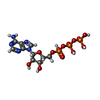




| #4: Chemical | | #5: Chemical | #6: Chemical | ChemComp-DEX / | |
|---|
-Details
| Has ligand of interest | N |
|---|
-Experimental details
-Experiment
| Experiment | Method: ELECTRON MICROSCOPY |
|---|---|
| EM experiment | Aggregation state: PARTICLE / 3D reconstruction method: single particle reconstruction |
- Sample preparation
Sample preparation
| Component | Name: Complex of the Glucocorticoid Receptor ligand binding domain, Hsp90 alpha dimer, and the co-chaperone p23 Type: COMPLEX / Entity ID: #1-#3 / Source: RECOMBINANT |
|---|---|
| Molecular weight | Value: 0.263 MDa / Experimental value: NO |
| Source (natural) | Organism:  Homo sapiens (human) Homo sapiens (human) |
| Source (recombinant) | Organism:  |
| Buffer solution | pH: 7.5 |
| Specimen | Embedding applied: NO / Shadowing applied: NO / Staining applied: NO / Vitrification applied: YES |
| Specimen support | Grid material: COPPER / Grid mesh size: 400 divisions/in. / Grid type: Quantifoil R1.2/1.3 |
| Vitrification | Instrument: FEI VITROBOT MARK IV / Cryogen name: ETHANE / Humidity: 100 % / Chamber temperature: 283 K |
- Electron microscopy imaging
Electron microscopy imaging
| Experimental equipment |  Model: Titan Krios / Image courtesy: FEI Company |
|---|---|
| Microscopy | Model: FEI TITAN KRIOS |
| Electron gun | Electron source:  FIELD EMISSION GUN / Accelerating voltage: 300 kV / Illumination mode: FLOOD BEAM FIELD EMISSION GUN / Accelerating voltage: 300 kV / Illumination mode: FLOOD BEAM |
| Electron lens | Mode: BRIGHT FIELD / Nominal magnification: 105000 X / Nominal defocus max: 2000 nm / Nominal defocus min: 800 nm / Cs: 2.7 mm / Alignment procedure: COMA FREE |
| Specimen holder | Cryogen: NITROGEN / Specimen holder model: FEI TITAN KRIOS AUTOGRID HOLDER |
| Image recording | Average exposure time: 5.9 sec. / Electron dose: 60 e/Å2 / Film or detector model: GATAN K3 BIOQUANTUM (6k x 4k) / Num. of real images: 5608 |
| EM imaging optics | Energyfilter name: GIF Bioquantum / Energyfilter slit width: 20 eV |
- Processing
Processing
| EM software |
| ||||||||||||||||||||||||||||||||
|---|---|---|---|---|---|---|---|---|---|---|---|---|---|---|---|---|---|---|---|---|---|---|---|---|---|---|---|---|---|---|---|---|---|
| CTF correction | Type: PHASE FLIPPING AND AMPLITUDE CORRECTION | ||||||||||||||||||||||||||||||||
| Particle selection | Num. of particles selected: 6062152 | ||||||||||||||||||||||||||||||||
| Symmetry | Point symmetry: C1 (asymmetric) | ||||||||||||||||||||||||||||||||
| 3D reconstruction | Resolution: 2.56 Å / Resolution method: FSC 0.143 CUT-OFF / Num. of particles: 140217 / Symmetry type: POINT | ||||||||||||||||||||||||||||||||
| Atomic model building | 3D fitting-ID: 1 / Source name: PDB / Type: experimental model
|
 Movie
Movie Controller
Controller



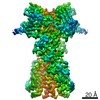






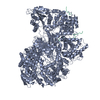

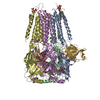
 PDBj
PDBj